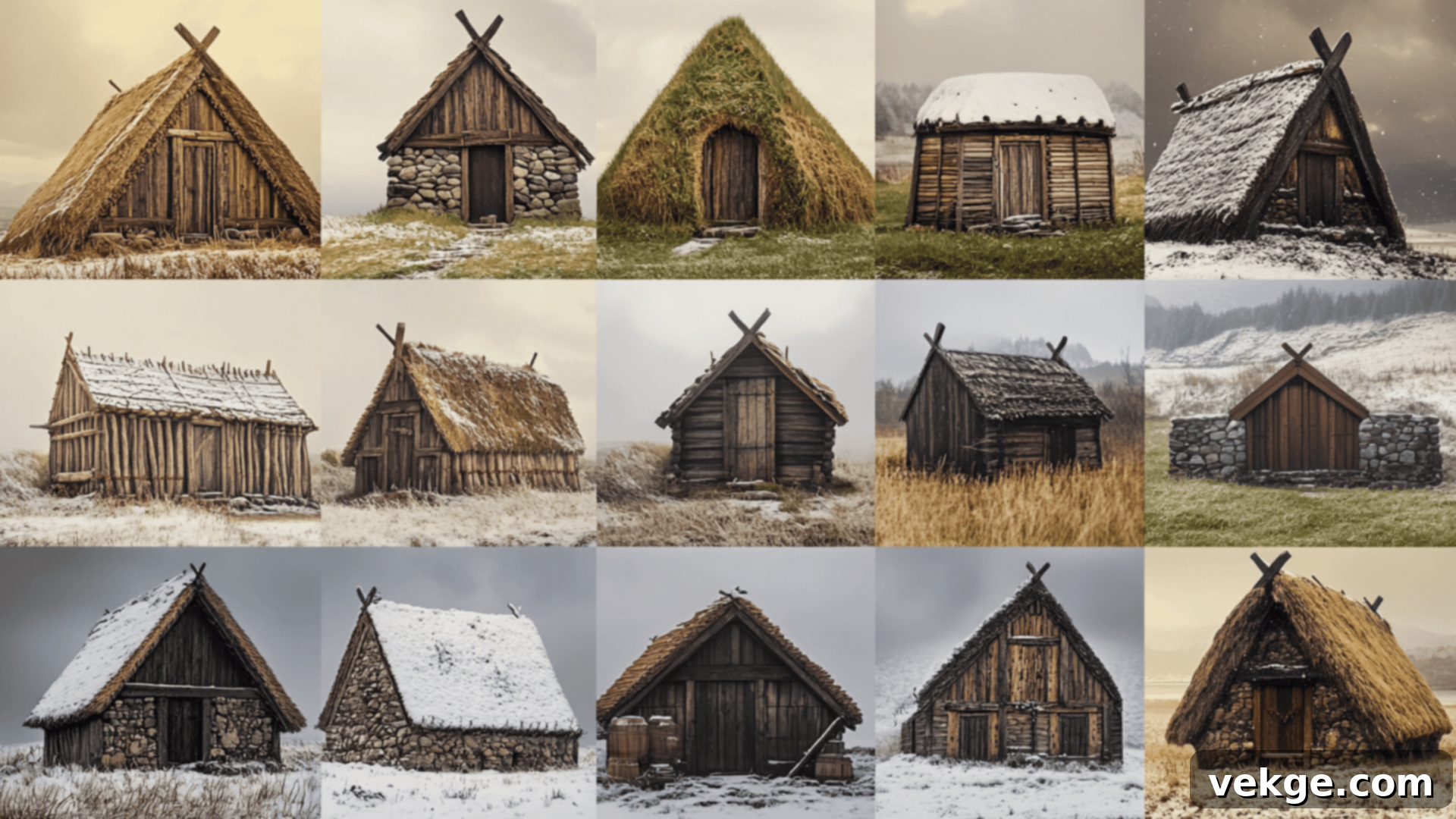Discover Authentic Viking Houses: Journey Through Ancient Norse Settlements
Step back in time and unlock the secrets of Viking daily life. Far more than simple shelters, Viking houses were ingeniously crafted to withstand harsh northern winters and support a challenging existence. While many have succumbed to the relentless march of time, a precious few original remains endure, and several magnificent reconstructions offer an unparalleled glimpse into the world of the Norse.
Imagine walking where Vikings once gathered, slept, and worked over a thousand years ago. This comprehensive guide invites you on a unique historical journey to the most significant sites where authentic Viking houses and their meticulously recreated counterparts stand today. These locations provide a tangible connection to Viking heritage, bringing their history vividly to life.
Prepare to explore real Viking house sites and their impressive reconstructions across:
- Norway
- Denmark
- Iceland
- Germany
- The United Kingdom
If you’ve ever dreamt of understanding the true essence of Viking living, these archaeological sites and living history museums offer an immersive experience that no traditional exhibit can match. They are vital windows into the domestic world of the legendary Norse people.
What Authentic Viking Homes Were Really Like
Viking homes were masterful examples of practical architecture, meticulously designed not just for shelter, but for collective survival and community cohesion. The dominant and most recognizable style was the iconic Viking longhouse. These formidable structures were typically long, narrow, and rectangular, constructed primarily from robust timber, often with walls crafted using wattle and daub, and topped with thick, insulating roofs of thatch or turf.
Stepping inside a longhouse reveals a fascinating world. A large, central hearth served as the beating heart of the home, providing essential heat for warmth and a constant source for cooking family meals. During the brutal winter months, it was common for families to share their living quarters with livestock, benefiting from the animals’ body heat for added warmth and ensuring their protection from the elements. Interior spaces were largely communal, lacking the rigid division of modern homes. Simple partitions, perhaps made of woven hangings or low wooden screens, might have separated sleeping areas from communal living and working spaces, emphasizing a collective lifestyle.
However, the diversity of Viking architecture was considerable, adapting ingeniously to the varied landscapes and available resources across the Norse world:
-
Turf Houses: Particularly prevalent in resource-scarce Iceland, these homes were constructed using layers of grass and earth over a wooden frame, providing exceptional insulation against the island’s fierce winds and cold temperatures. This distinctive style is a testament to the Vikings’ ingenuity.
-
Pit Houses (Grubenhäuser): Found in some colder regions, these dwellings were partially excavated into the ground. The earth provided natural insulation, keeping the interior warmer in winter and cooler in summer, demonstrating an early understanding of geothermal principles.
-
Stone Footings: In areas where large timbers were less abundant, such as parts of the Scottish Isles or Greenland, Vikings utilized stone for the lower parts of their walls or as foundational elements. This not only added significant stability and strength but also helped to protect the wooden superstructure from damp ground.
Every regional variation in Viking housing underscored a profound adaptability to local climates, available building materials, and the specific needs of the local Viking communities, from farmers and fishermen to traders and chieftains.
Explore Real Viking Houses and Reconstructions Today
For those eager to connect with the past, the Viking world offers an incredible array of sites where you can witness authentic Viking houses and their meticulous reconstructions. These locations provide an unparalleled opportunity to walk in the footsteps of the Norse, offering a tangible sense of their daily lives and architectural prowess. Let’s delve into some of the most remarkable Viking settlements and dwellings that have been preserved or brought back to life.
1. Borg Longhouse Ruins (Lofoten, Norway)

The site of Borg in the picturesque Lofoten Islands is home to one of the most astonishing discoveries in Viking archaeology: the largest chieftain’s longhouse ever unearthed in Norway. Measuring an impressive 83 meters (272 feet) in length, this monumental structure was not merely a home but a symbol of immense power, wealth, and influence. It served as the residence for a powerful Viking chieftain, a communal feasting hall, and a center for trade and social gatherings, reflecting the intricate social hierarchy of the Viking Age.
While the original foundations of this ancient Viking dwelling are preserved, visitors to the Lofotr Viking Museum can experience a breathtaking, full-scale reconstruction built precisely on the original site. This replica allows you to step inside and truly visualize the grandeur and daily rhythms of a Viking leader’s life, making it one of the premier destinations for exploring authentic Viking culture.
-
Type: Elite Chieftain’s Longhouse
-
Access: Fully accessible reconstruction at the Lofotr Viking Museum, offering immersive exhibits and activities.
2. Gjellestad Longhouse (Halden, Norway)
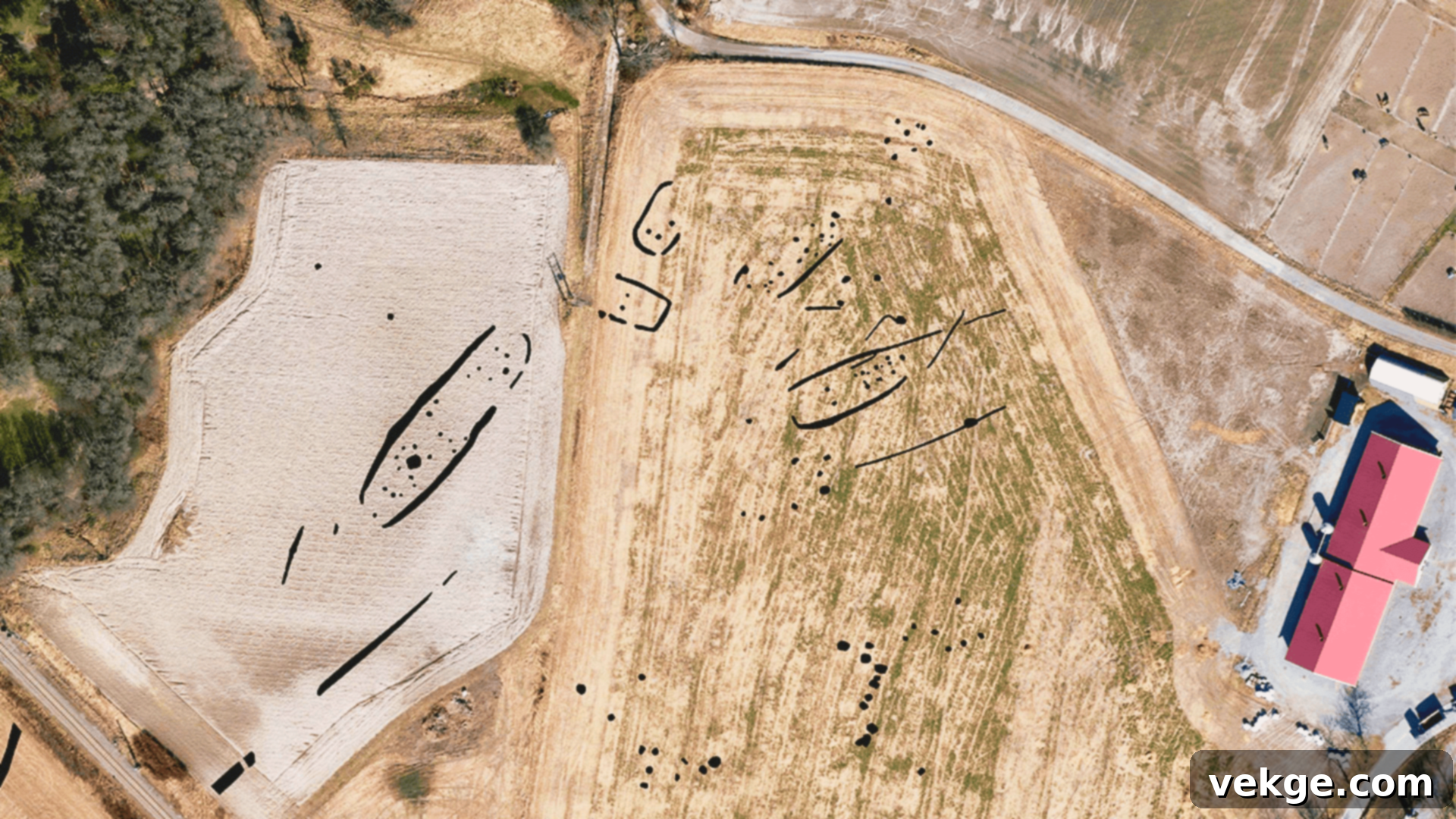
The Gjellestad site, located near Halden in southeastern Norway, represents one of the most thrilling and significant archaeological discoveries of recent years in the realm of Viking Age studies. Discovered using ground-penetrating radar in 2018, this site revealed not only a monumental Viking ship burial but also the clear outlines of an exceptionally large longhouse, believed to be over 60 meters (nearly 200 feet) long.
This elite longhouse is thought to have been intricately linked to the prominent royal burial mounds found nearby, suggesting it belonged to a family of significant power and status within the early Norse society. As active excavation and research are still ongoing, the Gjellestad site continues to yield invaluable insights into Viking settlement patterns, social structures, and funerary practices. While direct access to the active archaeological dig may be limited, the site itself offers a profound connection to a burgeoning understanding of real Viking architecture.
-
Type: Elite Longhouse, potentially part of a royal complex.
-
Access: The site is visible, with ongoing archaeological work. Visitor access might be restricted to specific viewing areas or guided tours, so check local information.
3. Trelleborg Viking Fortress (Slagelse, Denmark)
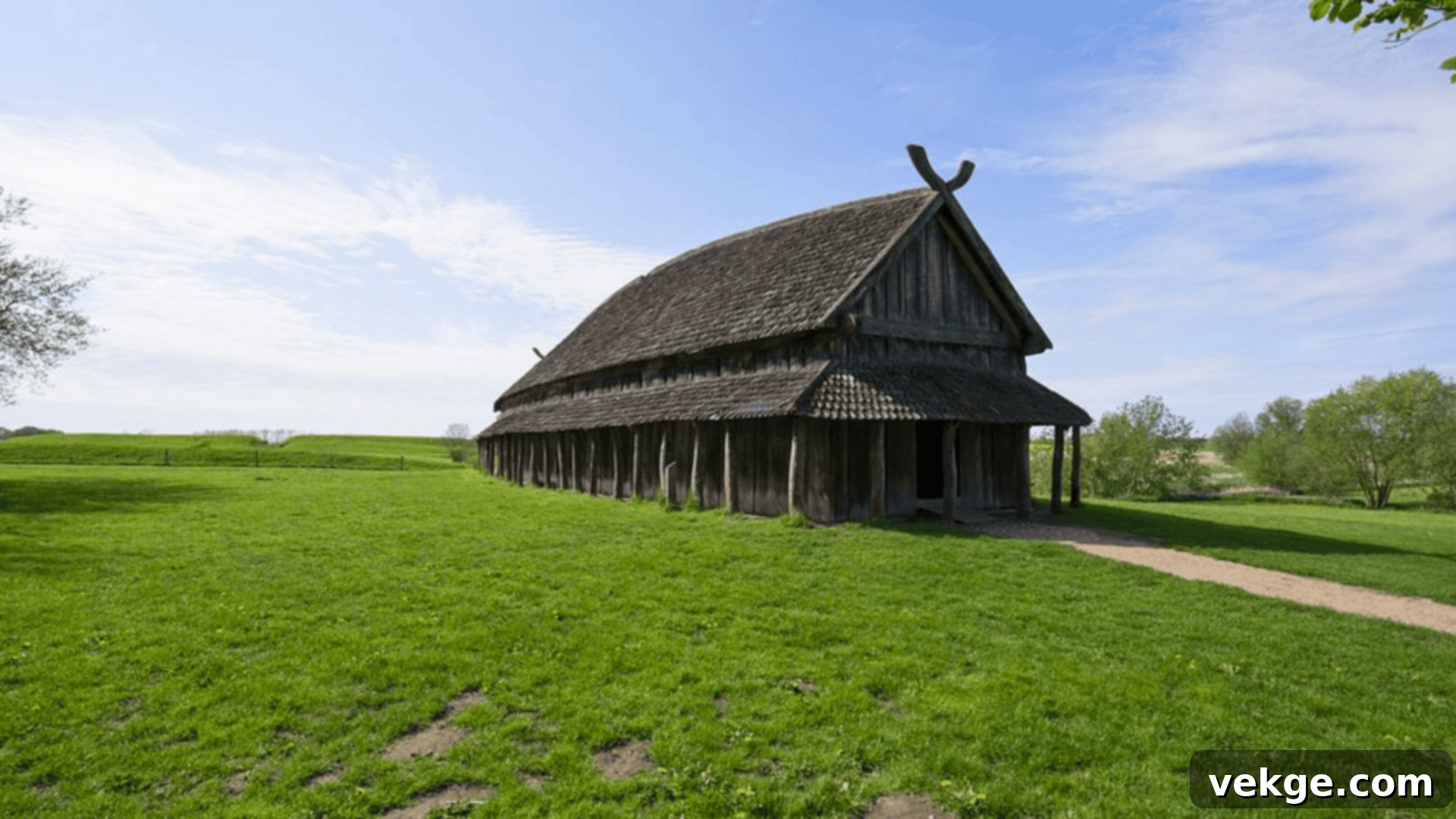
Trelleborg stands as one of Denmark’s best-preserved and most fascinating ring fortresses, a remarkable example of Viking military architecture and urban planning from the late 10th century. Within its circular ramparts, archaeologists have uncovered the foundations of numerous identical longhouses, designed to house the warriors and their families stationed at the fort. These meticulously planned settlements reveal a highly organized society, combining military strategy with the practicalities of daily life.
Today, visitors can explore the impressive earthen ramparts and the precise outlines of where the original Viking houses once stood. Several full-scale reconstructions of these curved longhouses now stand within the fortress, offering a vivid depiction of how soldiers and their families lived, worked, and trained. The associated museum provides further context, showcasing artifacts and explaining the strategic importance of these unique Viking fortresses.
-
Type: Military Garrison Housing within a ring fortress.
-
Access: Open-air museum with well-preserved earthworks, archaeological foundations, and detailed longhouse reconstructions. Includes a visitor center and museum.
4. Hedeby (Haithabu) House Foundations and Reconstructions (Germany)
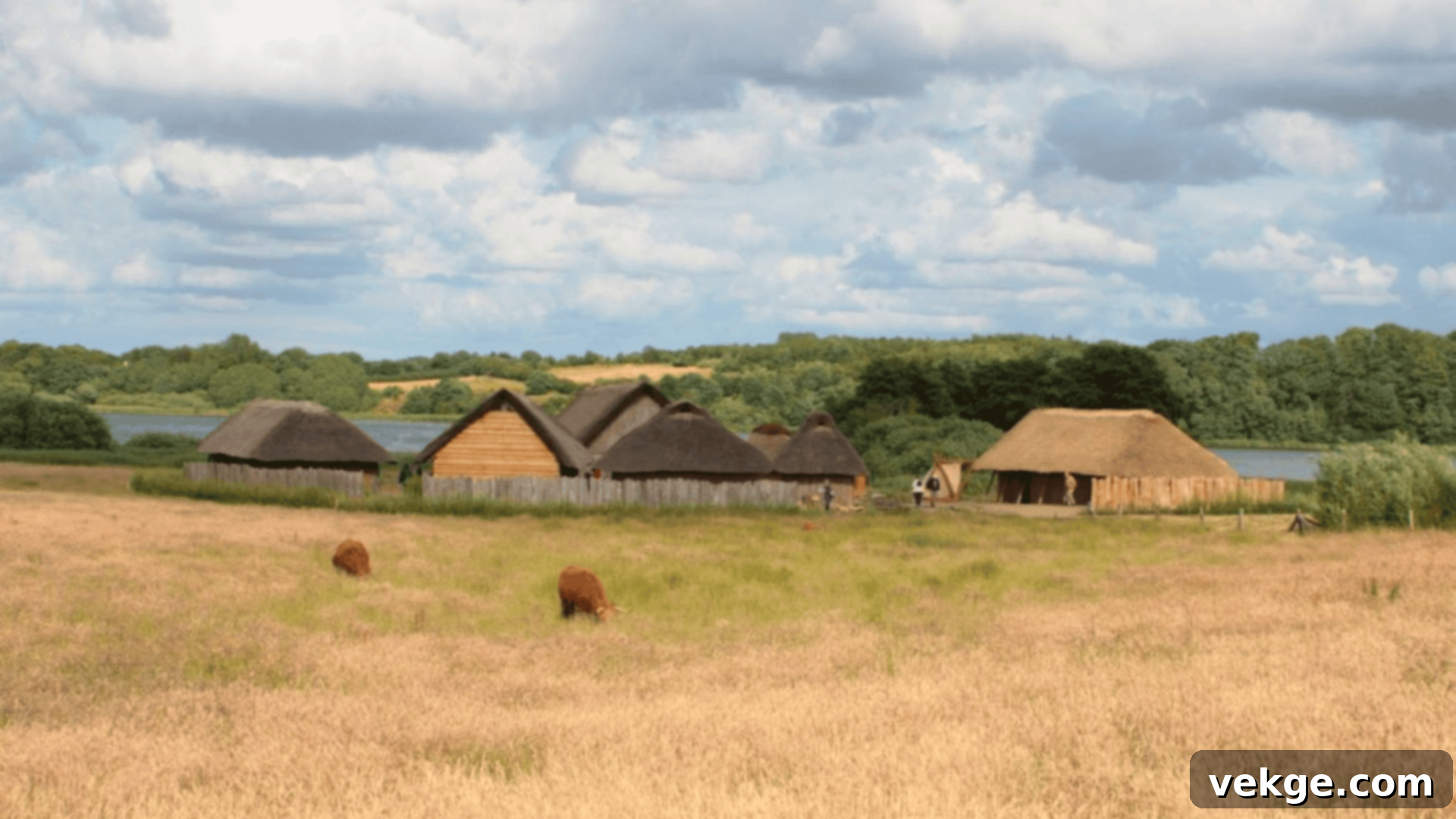
Hedeby (Haithabu in German) was one of the most crucial and bustling Viking Age trading settlements in Northern Europe, flourishing between the 8th and 11th centuries. Situated strategically at the narrowest point between the Baltic and North Seas, it served as a vital hub for commerce, connecting Scandinavia with the Frankish Empire and beyond. Archaeological excavations here have revealed an astonishingly dense urban environment, packed with a variety of Viking homes, workshops, market stalls, and well-organized roadways.
Today, the UNESCO World Heritage site of Hedeby offers a unique window into Viking urban life. Visitors can explore the impressive earthworks and the detailed outlines of where the original buildings stood. A cluster of meticulously researched and reconstructed Viking houses, based on archaeological evidence, vividly demonstrates the layout and domestic conditions of a Viking town. The accompanying Viking Museum Haithabu displays an incredible collection of artifacts, further illustrating the daily routines and sophisticated craftsmanship of the Hedeby inhabitants.
-
Type: Urban dwellings and trade-oriented homes.
-
Access: Extensive open-air museum with archaeological remains, reconstructed Viking buildings, walking trails, and a modern museum exhibiting numerous artifacts.
5. Jorvik Viking Centre (York, United Kingdom)

Beneath the bustling streets of modern-day York lies the remarkably preserved Anglo-Scandinavian city of Jorvik, a testament to the extensive Viking presence in England from the 9th to the 11th centuries. The exceptional anaerobic conditions of the soil preserved an extraordinary wealth of organic materials, including the wooden foundations of Viking homes, their streets, workshops, and countless everyday objects like tools, pottery, and even clothing fragments. This treasure trove of archaeological finds has provided an unparalleled insight into urban Viking life.
The Jorvik Viking Centre offers an immersive and sensory experience that transports visitors directly into the heart of a reconstructed Viking Age street and its dwellings, based on the very excavations beneath your feet. You can “ride” through recreations of these remarkably detailed Viking houses, complete with sights, sounds, and even smells, offering a truly unique perspective on the domestic routines, crafts, and social interactions of a bustling Viking town.
-
Type: Urban Dwellings, workshops, and market stalls.
-
Access: Indoor museum with a ride-through experience featuring full-scale, animated reconstructions of Viking homes and street scenes, alongside original artifacts.
6. Glaumbær Farm Turf Structures (North Iceland)

While the existing turf farmhouses at Glaumbær in northern Iceland are not strictly from the Viking Age, they represent an incredibly important continuous architectural tradition that directly evolved from the original Viking settlement patterns. These iconic Icelandic turf houses vividly demonstrate the enduring legacy of Viking-era building styles, adapted over centuries to the unique and challenging climate of Iceland.
With their remarkably thick, insulating turf walls and low-slung, sturdy timber frames, these structures were expertly designed to offer maximum protection against the relentless snow, strong winds, and harsh temperatures that define Icelandic winters. Visiting Glaumbær provides an exceptional opportunity to explore a cluster of beautifully preserved traditional farm buildings, allowing visitors to understand the ingenuity and resilience of early Icelandic settlers and how their homes provided sanctuary for generations of families.
-
Type: Traditional Rural Turf Homes (reflecting Viking-era building principles).
-
Access: Preserved open-air museum with multiple turf farm buildings, offering guided tours and insights into Icelandic agricultural history and domestic life.
7. Reykjavik Settlement Exhibition (Reykjavik, Iceland)
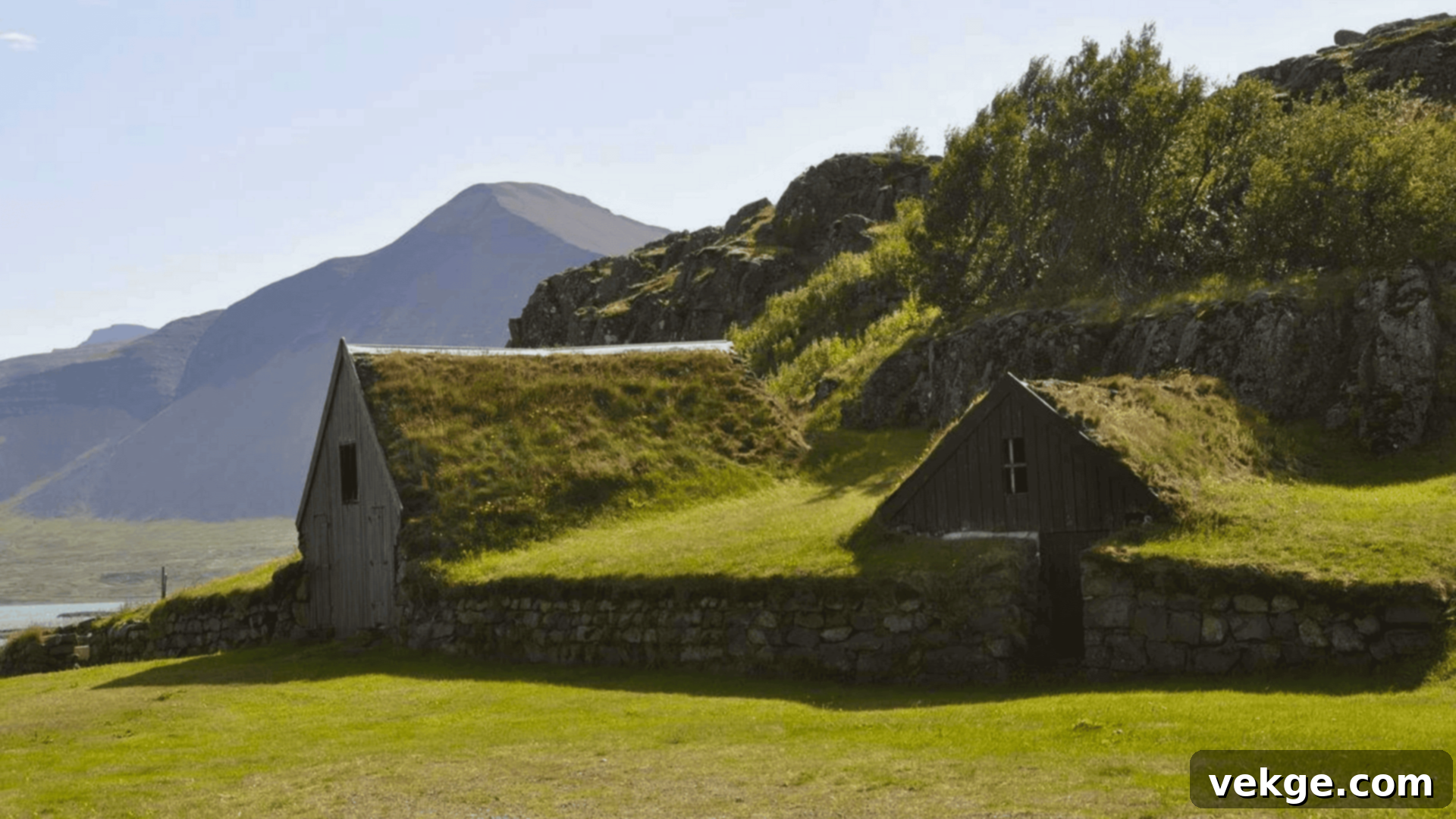
Beneath the modern capital of Reykjavik lies some of the earliest evidence of Viking settlement in Iceland, dating back to the late 9th and early 10th centuries. The Settlement Exhibition is built around the archaeological remains of a large, well-preserved Viking longhouse, believed to be one of the very first structures built by the Norse settlers. This impressive turf house, with its thick walls crafted from local materials, provides compelling proof of how these early Vikings ingeniously adapted their building techniques to Iceland’s unique environment, using readily available turf and stone to create resilient homes.
The exhibition allows visitors to view the actual foundations of this ancient Viking home, offering a direct connection to the country’s founding history. Interactive displays and multimedia presentations bring the world of the first settlers to life, explaining their domestic practices, the challenges they faced, and how these turf homes provided essential shelter and warmth in a new and often unforgiving landscape. It’s an essential stop for understanding the practicalities of early Viking life in Iceland.
-
Type: Early Viking Settler Longhouse.
-
Access: Indoor museum built directly over the archaeological remains of a Viking longhouse. Features interactive exhibits and artifacts.
8. Kaupang Settlement (Larvik, Norway)

Kaupang, located in Vestfold, holds the prestigious title of Norway’s first known Viking town and one of the earliest urban settlements in Scandinavia, active from the early 9th century. This bustling maritime trading hub, known as “Skiringssalr” in Old Norse, was a vibrant center for commerce, craftsmanship, and cultural exchange. Archaeological excavations have revealed evidence of numerous wooden structures, including homes, workshops, and market stalls, all built to support its seasonal yet intense trading activities.
While the original wooden buildings have long since decayed, the archaeological site of Kaupang allows visitors to walk through the footprint of this ancient Viking settlement. Clearly marked outlines and interpretative signs indicate where buildings once stood, giving a powerful sense of the town’s layout and scale. The adjacent visitor center provides detailed information on the finds, the lives of its inhabitants, and the vital role Kaupang played in the wider Viking trading networks, making it a crucial site for understanding early Norse urban and domestic life.
-
Type: Early Urban Trading Settlement with merchant homes and workshops.
-
Access: Open-air archaeological park with marked foundations of Viking houses and other structures, visitor center with exhibits.
9. Borre Mound Area (Horten, Norway)
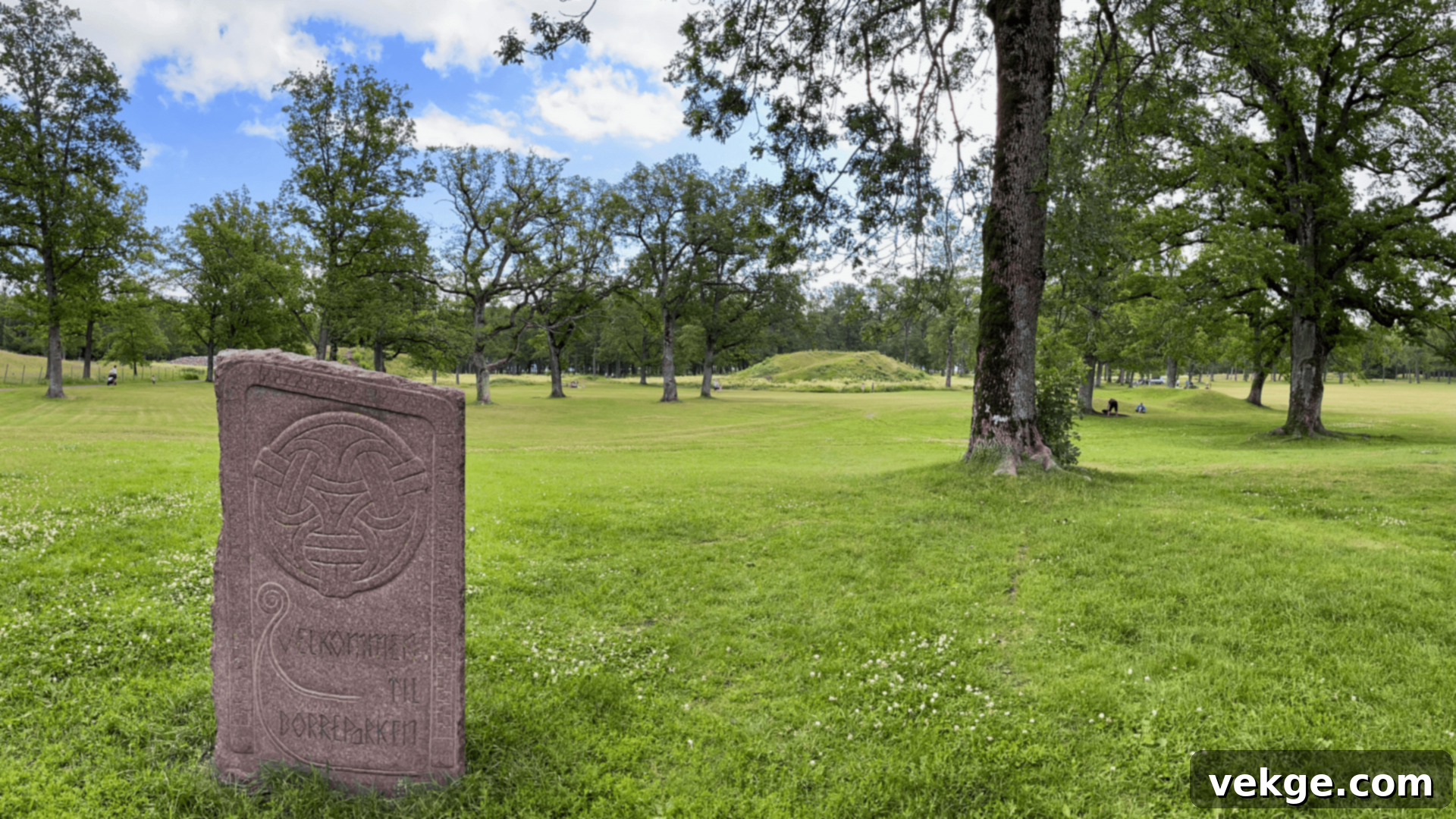
The Borre Mound Area, part of the Borre National Park in Vestfold, is one of Scandinavia’s most significant ancient burial grounds, offering profound insights into the elite Viking society. This impressive site features a collection of large burial mounds, some believed to be the final resting places of powerful Viking chieftains and kings from the Yngling dynasty. While the focus is often on the elaborate ship burials found here, archaeological surveys have also uncovered evidence of large wooden buildings in the vicinity, indicating a close relationship between ceremonial burial sites and elite residential areas.
It is hypothesized that these structures were grand longhouses, potentially serving as royal residences, halls for feasting and political gatherings, or even cultic buildings, linked directly to the powerful individuals interred in the mounds. The Midgard Historical Centre, located adjacent to the park, features a magnificent reconstruction of a Viking great hall, allowing visitors to step into a space that echoes the grandeur of the structures that once stood near these sacred burial sites. This unique combination makes Borre an essential destination for understanding both the domestic and spiritual aspects of Viking Age power.
-
Type: Elite Residential Structures (adjacent to royal burial mounds).
-
Access: Historic park with impressive burial mounds. The Midgard Historical Centre offers a large reconstructed Viking hall and exhibits.
10. Sagnlandet Lejre (Land of Legends) (Lejre, Denmark)

Sagnlandet Lejre, often referred to as the Land of Legends, is a sprawling open-air museum and archaeological research center located near Roskilde, Denmark. This significant site is deeply connected to ancient Danish history and the legendary origins of the earliest Danish kings, with archaeological findings suggesting it was a prominent power center during the Viking Age. While not purely original ruins, Lejre excels in bringing the past to life through meticulously researched and constructed full-size Viking houses and an entire reconstructed Viking village.
Based on extensive archaeological evidence, these Viking homes allow visitors to explore the domestic architecture and daily routines of people from different historical periods, including the Iron Age and the Viking Age. Sagnlandet Lejre is renowned for its immersive living history programs, where costumed interpreters engage visitors in hands-on activities, demonstrating ancient crafts, cooking, and social customs. It’s an interactive and educational experience that vividly illustrates what life inside a real Viking house and settlement truly entailed, making it an invaluable resource for understanding Viking social structures and architectural methods.
-
Type: Reconstructed Viking Village and royal halls.
-
Access: Large open-air museum featuring full-scale reconstructed Viking houses, living history demonstrations, and various hands-on educational programs.
Inside a Real Viking Home: Understanding Norse Domestic Life
To truly appreciate a Viking house, one must look beyond its external appearance and understand the intricate design and multifunctional nature of its interior. Viking homes, particularly the longhouses, were meticulously crafted to optimize warmth, foster community, and serve every aspect of daily life for both humans and often, animals. Every feature, from the materials used to the layout, was chosen for maximum efficiency in a challenging climate.
The following table provides a concise overview of the key features that defined the interior of a typical Viking dwelling, showcasing the ingenious solutions developed by the Norse people to create resilient and thriving domestic spaces:
| Feature | Details |
|---|---|
| Materials Used | Primarily timber, often combined with clay (wattle and daub) or thick layers of turf and stone. These materials, along with deeply insulated roofs, were chosen for their excellent thermal properties to retain warmth effectively. |
| Shape of Structure | Many longhouses featured a distinctive, slightly curved, boat-like shape. This design was not only aesthetically pleasing but also structurally advantageous, providing enhanced stability against strong winds and further aiding in heat retention. |
| Interior Layout | Typically, a Viking home consisted of one large, open communal room. Internal divisions were minimal, often using simple wooden screens, woven hangings, or short partitions to delineate specific areas without isolating family members. |
| Sleeping Areas | Along the interior walls, raised wooden platforms or built-in benches served as dedicated sleeping berths. These versatile structures also functioned as seating during the day, maximizing the use of limited space. |
| Central Hearth | The unquestionable heart of every Viking home was the central hearth. Strategically located in the middle of the main room, it was indispensable for heating the entire dwelling, cooking meals, and served as the primary gathering point for family and community life. Smoke escaped through a vent in the roof. |
| Animal Shelter | A common practice, especially in colder regions during winter, was to bring livestock into a section of the longhouse. This provided animals with vital protection from the elements and contributed significantly to the overall warmth of the dwelling through their body heat. |
| Storage Solutions | Efficiency was key. Built-in shelves, sturdy wooden chests, and benches along the walls were ingeniously utilized to store a wide array of tools, foodstuffs, clothing, and other essential household items, keeping the living space organized. |
| Indoor Work | During inclement weather, the longhouse transformed into a vibrant workshop. Activities such as weaving, spinning, woodworking, toolmaking, and repairs were carried out indoors, often around the warm, central hearth, demonstrating the home’s multi-functional nature. |
| Function of the House | A Viking home was far more than a mere shelter. It was a dynamic, integrated living environment that encompassed living, working, social interaction, and even livestock protection, serving as the nucleus of the entire family’s existence. |
The Enigma of Disappearance: Why So Few Viking Homes Survived
The scarcity of intact, original Viking homes often puzzles visitors to archaeological sites. The primary reason for their ephemeral nature lies in their ingenious, yet ultimately biodegradable, construction materials. Most Viking dwellings, particularly the widespread longhouses, were predominantly built from organic resources such as timber, turf, wattle (woven branches), and daub (a mixture of clay, sand, and straw). While these natural materials were highly effective for insulation, readily available, and allowed for relatively rapid construction, they were inherently impermanent.
Over the centuries, the wooden structural elements were susceptible to rot, the turf roofs gradually collapsed under the weight of time and weather, and the wattle and daub walls disintegrated. This natural decay process, combined with a lack of consistent maintenance over generations, ensured that most of these once-vibrant homes slowly dissolved back into the earth, leaving behind only the faintest archaeological traces.
Furthermore, the relentlessly harsh climates of Scandinavia and the North Atlantic — characterized by incessant rain, heavy snowfalls, frost heaving, and shifting soil — significantly accelerated the deterioration. Exposed wooden structures were subjected to constant moisture and temperature fluctuations, while turf roofs required regular re-turfing to remain watertight. Without continuous occupancy and diligent upkeep, the elements relentlessly wore away these ancient dwellings.
Cultural and societal shifts also played a crucial role in the disappearance of many Viking settlements. With the gradual spread of Christianity across the Norse world, traditional pagan sites and ways of life were often abandoned or intentionally superseded. Existing Viking homes and entire settlements were sometimes buried, repurposed, or completely dismantled to make way for new Christian churches, monasteries, and evolving urban centers. Many simply faded into the landscape as populations moved or building practices changed.
Despite these challenges, a precious few Viking sites have survived, often due to accidental preservation. Some were buried rapidly under layers of sand, volcanic ash, or peat, creating anaerobic conditions that inhibited decay. In other remarkable instances, modern archaeology, employing meticulous excavation techniques and scientific analysis of postholes, hearths, and subtle ground disturbances, has allowed experts to accurately map and, in some cases, reconstruct these ancient Viking homes. These reconstructions, built on sound archaeological evidence, are our best window into the physical reality of Viking architecture and domestic life.
Planning Your Journey: Visiting Real Viking Homes Today
Embarking on a journey to explore authentic Viking homes is an incredibly rewarding experience, offering a unique bridge to the ancient Norse world. When you visit these sites today, you’ll encounter a rich tapestry of historical preservation and innovative interpretation. This typically includes a combination of original archaeological ruins, where only the stone footings or faint outlines of former dwellings remain, and impressive full-scale reconstructions meticulously built based on extensive archaeological evidence and historical research.
These varied approaches provide different, yet equally valuable, perspectives. For instance, at Kaupang in Norway, you can quietly contemplate the marked foundations of the Viking Age’s first urban settlement, allowing your imagination to fill the gaps where bustling homes and markets once stood. In stark contrast, the Lofotr Viking Museum in Norway offers a robust, rebuilt chieftain’s longhouse that you can physically enter, providing an immersive sense of the space, light, and atmosphere of a grand Viking dwelling.
Many of the premier Viking museums and archaeological parks worldwide enhance the visitor experience with interactive and sensory exhibits. The renowned JORVIK Viking Centre in York, England, for example, masterfully recreates a segment of a Viking street, complete with lifelike figures, ambient sounds, and even historically accurate scents, allowing you to “travel” through a Viking village and witness daily life. Similarly, the House of Manannan on the Isle of Man creatively illustrates the blending of Viking and Celtic cultures through life-sized rooms and displays of original artifacts.
To guide your exploration of these remarkable sites, here are some of the best countries renowned for their Viking history and preserved homes:
-
Norway: A treasure trove of Viking history, featuring significant archaeological sites like Kaupang and Borre, alongside immersive museums such as the Lofotr Viking Museum with its iconic longhouse reconstruction, and the world-famous Viking Ship Museum in Oslo (currently under renovation for a new museum).
-
Denmark: Home to strategically important ring fortresses like Trelleborg, where reconstructed warrior houses stand, and the National Museum of Denmark in Copenhagen, which houses a vast collection of Viking artifacts and provides context on domestic life.
-
United Kingdom: Offers diverse Viking experiences, particularly in York with the JORVIK Viking Centre, fascinating archaeological finds and reconstructions in Scotland (like Jarlshof), and the rich Viking-Celtic heritage on the Isle of Man.
-
Iceland: A land shaped by its Viking settlers, showcasing early turf house remains at sites like the Settlement Exhibition in Reykjavik, and broader Viking exhibits in the National Museum of Iceland, highlighting unique adaptations to the local environment.
-
Germany: The UNESCO World Heritage site of Hedeby (Haithabu) provides an exceptional look at a thriving Viking trade town, with preserved foundations and reconstructed merchant homes.
Each destination provides a distinct window into the Viking Age. Whether you prefer walking among ancient ruins, engaging with living history interpreters, or exploring detailed museum exhibits, these sites collectively offer a profound and memorable connection to the people who inhabited these remarkable Viking homes over a millennium ago.
Conclusion: Stepping Into the Enduring Legacy of Viking Homes
The surviving remains and impressive reconstructions of Viking houses offer an unparalleled and deeply personal window into the daily lives of the Norse people. These ancient dwellings, from the grand chieftain’s longhouse to the humble turf farm, stand as powerful testaments to Viking ingenuity, their practical architectural solutions, and their profound connection to the landscape and community.
They reveal how Vikings masterfully utilized available resources, designed multi-functional spaces, and ingeniously maintained warmth and shelter during the formidable, long northern winters. More than just structures, these homes were the very heart of Viking society – places of family, craft, feasting, and survival.
Visiting these authentic sites and living history museums is undoubtedly one of the most enriching ways to truly grasp the essence of Viking life. To stand within the walls of a reconstructed longhouse, to walk over the foundations where ancient hearths once burned, is to forge a tangible link to a world that existed over a millennium ago. It is an experience that transcends mere historical facts, offering a visceral connection to the people and the culture that shaped much of early medieval Europe.
We hope this guide inspires your own journey to explore these magnificent remnants of the Viking Age. Have you had the opportunity to visit any real Viking houses or are you planning a trip to one of these fascinating sites soon? Share your experiences, insights, or any travel tips in the comments below – we would love to hear from you and continue the conversation about the enduring legacy of Viking homes!
